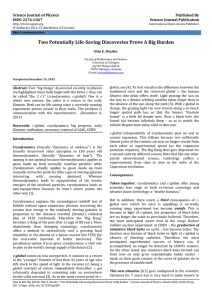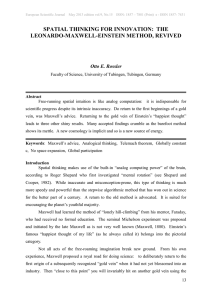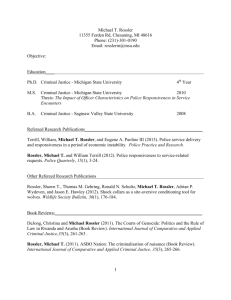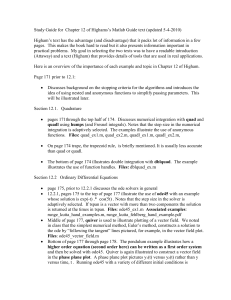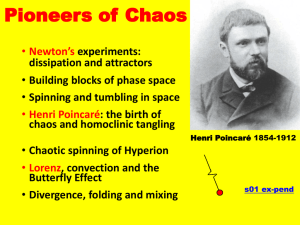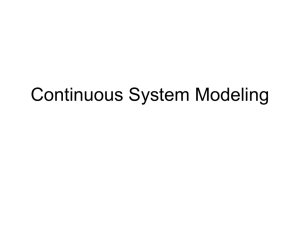ANTITHERMODYNAMICS - European Scientific Journal, ESJ
advertisement
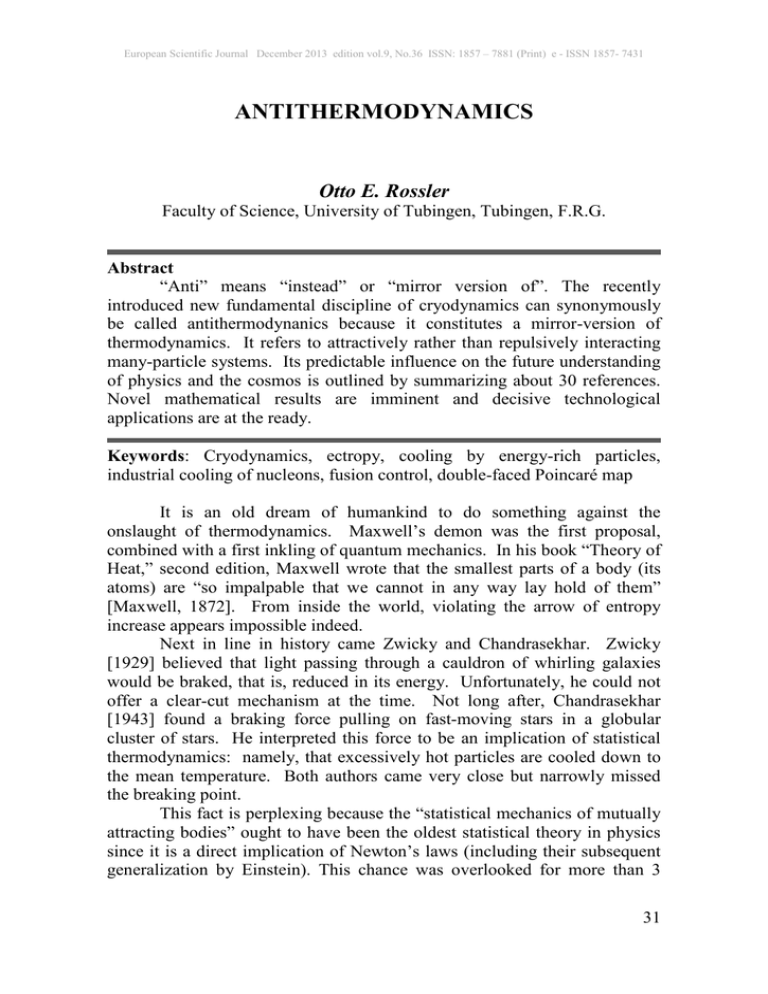
European Scientific Journal December 2013 edition vol.9, No.36 ISSN: 1857 – 7881 (Print) e - ISSN 1857- 7431 ANTITHERMODYNAMICS Otto E. Rossler Faculty of Science, University of Tubingen, Tubingen, F.R.G. Abstract “Anti” means “instead” or “mirror version of”. The recently introduced new fundamental discipline of cryodynamics can synonymously be called antithermodynanics because it constitutes a mirror-version of thermodynamics. It refers to attractively rather than repulsively interacting many-particle systems. Its predictable influence on the future understanding of physics and the cosmos is outlined by summarizing about 30 references. Novel mathematical results are imminent and decisive technological applications are at the ready. Keywords: Cryodynamics, ectropy, cooling by energy-rich particles, industrial cooling of nucleons, fusion control, double-faced Poincaré map It is an old dream of humankind to do something against the onslaught of thermodynamics. Maxwell’s demon was the first proposal, combined with a first inkling of quantum mechanics. In his book “Theory of Heat,” second edition, Maxwell wrote that the smallest parts of a body (its atoms) are “so impalpable that we cannot in any way lay hold of them” [Maxwell, 1872]. From inside the world, violating the arrow of entropy increase appears impossible indeed. Next in line in history came Zwicky and Chandrasekhar. Zwicky [1929] believed that light passing through a cauldron of whirling galaxies would be braked, that is, reduced in its energy. Unfortunately, he could not offer a clear-cut mechanism at the time. Not long after, Chandrasekhar [1943] found a braking force pulling on fast-moving stars in a globular cluster of stars. He interpreted this force to be an implication of statistical thermodynamics: namely, that excessively hot particles are cooled down to the mean temperature. Both authors came very close but narrowly missed the breaking point. This fact is perplexing because the “statistical mechanics of mutually attracting bodies” ought to have been the oldest statistical theory in physics since it is a direct implication of Newton’s laws (including their subsequent generalization by Einstein). This chance was overlooked for more than 3 31 European Scientific Journal December 2013 edition vol.9, No.36 ISSN: 1857 – 7881 (Print) e - ISSN 1857- 7431 centuries. The new science surfaced only slowly in a series of papers stimulated by ongoing discussions in the lecture hall with Dieter Fröhlich and my students. The so far accrued publications are listed as follows [Rossler et al., 2003a; Rossler, 2003a; 2003b; 2003c; Rossler, Letellier 2003; Rossler, Bosetti, 2004; Rossler, 2004; Rossler, 2004a; Rossler, Movassagh, 2005; Rossler et al., 2005a; Rossler, 2006; Rossler et al., 2007; Rossler, 2010a; 2010b; Sonnleitner, 2010; Rossler, 2011; Rossler, Kuske, 2011; Rossler, 2012a; 2012b; Rossler et al., 2012a; Rossler, 2012c; Rossler et al., 2012b; Rossler, 2013a; Rossler et al., 2013; Rossler, 2013b]. The underlying new phenomenon – braking-at-a-distance of poor-inkinetic energy particles by rich-in-kinetic energy particles under attractive conditions – appears to be empirically encountered down here on earth in the special case of “nucleon cooling” by means of high-energy electrons used in particle accelerators (cf. [Prashun et al., 2003]). This interpretation of the Jülich results waits to be discussed with the pertinent group. If it survives scrutiny, then the phenomenon much like “dynamical friction” before went unrecognized as being the expression of a universal anti-dissipative mechanism present in nature that contradicts thermodynamics but is exactly complementary to it. The proposal arrived at in Tübingen and Kos to use the same principle for stabilizing hot-fusion reactors [Rossler et al., 2012a; Rossler, 2012c; Rossler et al., 2013] is up to this day greeted with skeptical silence by the rest of the scientific community and the reactor industry. This fact is by no means surprising. Imagine someone comes up to say “I have a recipe for anti-entropy.” More than 1 1/2 centuries of thermodynamics, including the thermodynamics of irreversible processes explaining chemical and biological evolution, cannot but cause everyone to be maximally skeptical. This probabilistic judgment notwithstanding, the “second thermodynamics” exists. It almost exclusively applies in the cosmos, and it is in addition compounded here by the fact that it is numerically unstable – which explains why it got missed in galacticdynamics simulations for five decades. It got numerically confirmed only in 2010 by Klaus Sonnleitner in his dissertation [Sonnleitner, 2010] which has yet to be translated into English. Most everyone is still ready to show skepticism towards such a high-flying claim – especially if the author ironizes his own finding by calling it “energetic capitalism” since the energyrich particles exploit the energy-poor ones [Sonnleitner, 2010]. There exists a theory of “deterministic entropy” production in molecular-dynamics simulations under the usual repulsive conditions [Diebner, Rossler, 1998; 2004]. The same deterministic-entropy formula, only sign-inverted, predictably applies in the new attractive case, describing a numerically equal “deterministic ectropy.” 32 European Scientific Journal December 2013 edition vol.9, No.36 ISSN: 1857 – 7881 (Print) e - ISSN 1857- 7431 The mathematical breakthrough came with the geometric “plane-tree alley theorem” of deterministic statistical thermodynamics [Rossler, 2013b]. It represents a generalization towards smooth potentials of Sinai’s famous geometric proof of hard-repulsion-based equilibrium statistical thermodynamics [Sinai, 1970]. The new result not only includes far-fromequilibrium statistical thermodynamics, it also possesses a natural dual: the “inverted plane-tree alley problem.” Under sign inversion of all potentials – from Newtonian-repulsive to Newtonian attractive –, the light-weight fast particles were shown to be braked on average by the energy-rich heavy slow ones. The theorem proves this under artificially symmetrical assumptions which, however, can be relaxed without loss of generality [Rossler, 2013b]. The offered straightforward geometrico-mathematical demonstration can be generalized in many formal ways. An analytical treatment of a 2-body Newtonian interaction yielding the same outcome was presented by Movassagh [2013]. What is missing so far is an “industry” – as one calls the emergence of an accepted new paradigm. In the scientific community at large, the bonanza that is to be expected is not yet taken seriously enough to effectively motivate individuals or groups to undertake the immense effort of building up from scratch a full-fledged fundamental discipline on a par with theoretical and technical thermodynamics. The name – whether antithermodynamics or cryodynamics – makes no difference (it is hard to predict which term will be the winner). The present short report serves the purpose to help launch this maximally promising research effort. Numerical specialists need to be recruited. The T-tube allows for further low-mass fast particles to be added to the single one in the horizontal tube, all in a mutually transparent manner for simplicity. The author of the quoted dissertation could do this work himself – were his former advisor not unable to accrue support after the university took away his house for solidarity shown with two unjustly degraded colleagues. The most promising conjecture arrived at by Sonnleitner and the present author reads as follows: Replace the heavy vertical particle in the T-tube by a forcing function acting on the light particle in the horizontal bar having the same form as that exerted by the heavy particle, but having constant frequency. The cooling phenomenon will predictably persist while simultaneously the system has become an ordinary periodically forced Hamiltonian oscillator – the oldest paradigm of chaos theory invented by Poincaré [1885]. Who would have foreseen that a Poincaré cross section in an ordinary periodically forced Hamiltonian oscillator can harbor a second dynamical revolution after that brought by chaos? The pertinent area-preserving map waits to be plotted and analyzed for three years in a row. The ultimate difference between thermodynamics 33 European Scientific Journal December 2013 edition vol.9, No.36 ISSN: 1857 – 7881 (Print) e - ISSN 1857- 7431 and cryodynamics predictably lies hidden in the structure of this easily accessible but still unknown mathematical figure. It is hard to guess beforehand what could be the decisive difference between two related cross sections which, in the one case, cause the underlying area-preserving map to generate dissipative behavior under the far-from-equilibrium condition assumed, and in the other case, cause anti-dissipative behavior. One of the deepest secrets of nature – the progression of macroscopic time which has no basis in physics so far – may come closer to its resolution once this particular Poincaré map has been given the benefit of a comparative investigation of its two cases. To conclude, the new discipline presented in a nutshell above can cast a light on science as a whole. One always believes that progress is so slow because new discoveries – like a cancer drug or a lightweight battery or a stable quantum dot or an anticipated particle – are so time-consuming to harvest at a potentially unbounded cost. Here we see a dual obstacle to progress at work. A promising bonanza (like “hometown of humankind on the Internet” two decades ago) is sometimes irrationally shunned out of a phenomenon that could be called “collective modesty.” The concrete cause in the present case may be that there no longer exists a “club of old men” on the planet – like that formed by my late friends Carl-Friedrich von Weizsäcker, John Wheeler, Masaya Yamaguti, Ezer Weizmann and Stafford Beer three decades ago. The successor club (with Koichiro Matsuno and David Finkelstein) is too small to have enough influence since “specialists for nonspecialization” have become rare and far between. I would love to ask the current club whether they would be willing to endorse the following proposal: To set up a research and teaching institute for cryodynamics (“antidissipation”) – preferably in Tubingen because old trees abhor being transplanted. The rewards for science following in the footsteps of Poincaré one more time will – after the good experience made with chaos and fractality – be “unlimited” if the new cooling law proves as powerful as its dual nature to thermodynamics suggests. The reader is asked to search for a critical error in the above-reviewed Hamiltonian chaos theory. After all, the cosmological consensus of a planet is being put in jeopardy – so maximum skepticism is on line. Every young scientist is invited to participate since the numerical study of a periodically forced two-variable oscillator is state-ofthe-art for decades in the science of chaos. The circumspectness of the numerical study of 2010 waits to be taken up. Acknowledgments I thank Dieter Frohlich, Frank Kuske, Hans-Gunther Stadelmayr, Wolf Koch, Eric Klien, Nico Heller and Dan Stein for discussions. For J.O.R. 34 European Scientific Journal December 2013 edition vol.9, No.36 ISSN: 1857 – 7881 (Print) e - ISSN 1857- 7431 References: J.C. Maxwell, Theory of Heat. Appleton, New York 1872, p. 154. F. Zwicky, On the red shift of spectral lines through interstellar space. Proceedings of the National Academy of Sciences 15, 773–779 (1929). S. Chandrasekhar, Dynamical Friction, I. General considerations: the coefficient of dynamical friction. Astrophysical Journal 97, 255–262 (1943). O.E. Rossler, D. Frohlich and N. Kleiner, A time-symmetric Hubble-like law: light rays grazing randomly moving galaxies show distanceproportional redshift. Z. Naturforsch. 58 a, 807-809 (2003a). O.E. Rössler, Diffusion model of Hubble's law. In: Space Time Physics, Transfinite Mathematics and Computer Art. Zentrum für Kunst und Medientechnologie, Institut für Grundlagenforschung, Karlsruhe (P. Weibel, ed.). (Oct. 11, 2003a). O.E. Rossler, Eine neue uralte Kosmologie (2003b). http://www.etage.com/index.php?id=352 O.E. Rossler, D.O. Rudin, W. Graham and G.E. Lasker, Hamiltonian physics: a new idea on the big bang. In: Advances in Education, Vol. 5 (G.E. Lasker and G. Andonian, eds.), pp. 17-21. Windsor, Ontario, International Institute for Advanced Studies in Systems Research and Cybernetics 2003c. (ISBN 1-894612-29-5) O.E. Rossler and C. Letellier, Fermi deceleration re-encountered: recurrent grazing-type collisions with supermassive slow particles imply distanceproportional cooling (abstract). Rouen Chaos Conference, December 15, 2003. O.E. Rossler and P. Bosetti (Dialog), Big-bang busting. WechselWirkung 25, 102-109 (2004). O.E. Rossler, Cosmic shear’s temporal fluctuations generate distanceproportional redshift in both time directions: minibang theory. Chaos, Solitons and Fractals 19, 1335-1338 (2004a). O.E. Rossler and R. Movassagh, Bitemporal Sinai divergence: an energetic analog to Boltzmann’s entropy. Intern. J. Nonlinear Sciences and Numerical Simulation 6, 349-350 (2005), and arxiv. O.E. Rossler, G.E. Lasker and G. Andonian, A possibly consistent cosmology based on the dynamic weak-lensing paradigm. In: Advances in Education, Vol. 6 (G.E. Lasker and G. Andonian, eds.), pp. 13-17. Windsor, Ontario, Intern. Inst. for Advanced Studies in Systems Research and Cybernetics 2005a. (ISBN 1-894613-85-6) O.E. Rossler, Static cosmology from chaos-borne Hubble law. Nonlinear Phenomena in Complex Systems 9, 53-60 (2006). O.E. Rossler, D. Fröhlich, R. Movassagh and A. Moore, Hubble-expansion in static space time. Chaos, Solitons and Fractals 33, 770-775 (2007). 35 European Scientific Journal December 2013 edition vol.9, No.36 ISSN: 1857 – 7881 (Print) e - ISSN 1857- 7431 [Contains the testable prediction that the microwave background is not timeinvariant.] O.E. Rossler, Open Dialog with the Class of Olafur Eliasson. In: Otto’s Impossible Talks: Impossible Topics, Rescued Futures. Publications Institut für Raumexperimente, Universität der Kunste, Berlin 2010a. O.E. Rossler, No big bang, no safe black holes – please, dear CERN, start to listen. Leibniz Online 08/2010b. wwww.leibniz-sozietaet.de/journal K. Sonnleitner, “StV4: a symplectic time-reversible Stormer-Verlet th algorithm of the 4 order for Hamiltonian multi-particle systems – with worked applications (gas, T-tube model),” in German. PhD dissertation, University of Tübingen (2010). O.E. Rössler, The new science of cryodynamics and its connection to cosmology. Complex Systems 20, 105-113 (2011). O.E. Rossler and F. Kuske, Cryodynamics – the new second thermodynamics – demonstrated numerically. AIP Conf. Proc. 1389, 959961 (2011). O.E. Rössler, Hun-Tun versus Big Bang: how classical chaos implies both ‘thermodynamics’ and ‘cryodynamics’. Int. J. Bifurcation Chaos 22, 1230007 (2012a) [9 pages]. O.E. Rossler, Occam’s razor ‘avoid ad-hoc hypotheses!’ re-instituted in cosmology: two dozen violations healed. In: Advances in Architecture, Urbanity and Social Sustainability, Vol. 4 (Greg Andonian and George E. Lasker, eds.), pp. 15-21. Windsor, Ontario, Int. Inst. Advanced Studies (IIAS) 2012b. (ISBN 978-1-897233-63-4) O.E. Rossler, F. Kuske and A. Sanayei, Cryodynamics can solve the energy problem by stabilizing ITER: a prediction. International Conference of Numerical Analysis and Applied Mathematics, AIP Conf. Proc. 1479, 642645 (2012a). O.E. Rossler, Trillion Dollar Zwicky. Talk given at the ICNAAM, Sept. 22, 2012c on Kos, Greece. 50 min. (Youtube) http://www.youtube.com/watch?v=s73D0VIofFo O.E. Rossler, K. Sonnleitner and A. Sanayei, Deterministic anti-dissipation: a proposed explanation. Submitted to Complex Systems 2012b. O.E. Rossler, Short Summary of a New Idea: Cryodynamics (Jul 15, 2013a). http://lifeboat.com/blog/2013/07/short-summary-of-a-new-ideacryodynamics O.E. Rossler, A. Sanayei and I. Zelinka, Is hot fusion made feasible by the discovery of cryodynamics? In: Nostradamus: Modern Methods of Prediction, Modeling and Analysis of Nonlinear Systems (I. Zelinka, O.E. Rossler, V. Snásel, A. Abraham and E. Corchado, eds.), pp. 1-4. Springer Verlag, Berlin 2013. 36 European Scientific Journal December 2013 edition vol.9, No.36 ISSN: 1857 – 7881 (Print) e - ISSN 1857- 7431 O.E. Rossler, Rolling ball in breathing plane-tree alley paradigm. European Scientific Journal 9(27), 1-7 (2013b). D. Prasuhn et al., Status of the cooler synchrotron COSY – Jülich. Proceedings of the 2003 Particle Accelerator Conference, IEEE 5, 34283430 (2003). H.H. Diebner and O.E. Rossler, A deterministic entropy based on the instantaneous phase space volume. Z. Naturforsch. 53 a, 51-60 (1998). H.H. Diebner and O.E. Rössler, A deterministic entropy to monitor the evolution of microscopically simulated far-from equilibrium structures. Chaos, Solitons and Fractals 19, 699-703 (2004). Ya. Sinai, Dynamical systems with elastic reflections. Russ. Math. Surv. 25, 137-189 (1970). R. Movassagh, A time-asymmetric process in central force scatterings (2013). http://arxiv.org/abs/1008.0875 H. Poincare, Sur les courbes definies par des equations differentielles. Journal de Mathematiques Pures et Appliquees 1, 167-244 (1885). 37

